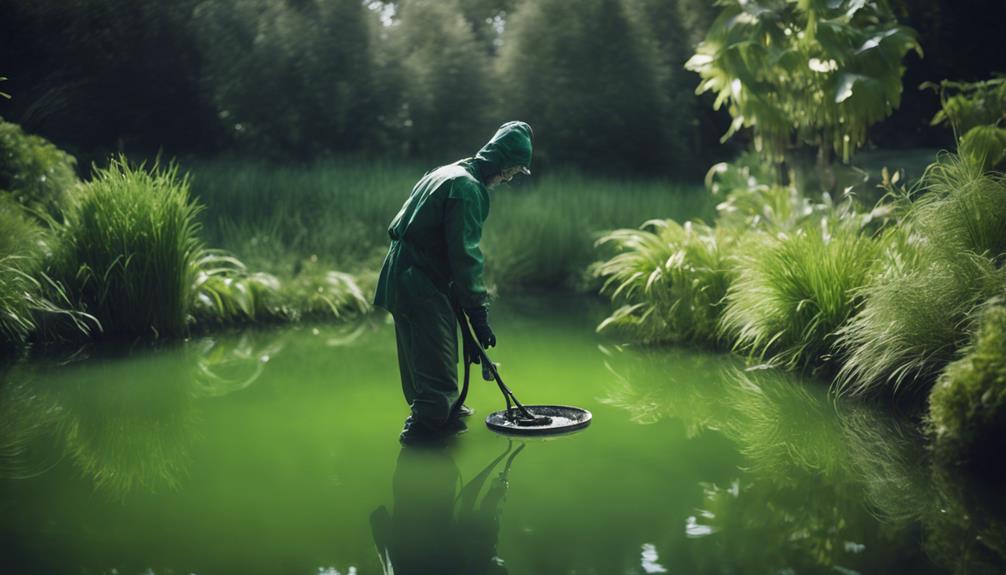To control pond algae, you'll need to prevent excess nutrients from entering the water, reduce sunlight exposure, and introduce beneficial bacteria. You can also add algae-eating fish species and use natural barriers like aquatic plants and submerged logs. Maintaining clean water circulation and balancing nutrient levels naturally are also vital. Regularly remove excess algae manually and monitor the pond's ecosystem to make adjustments as needed. By implementing these methods, you'll be well on your way to a balanced and thriving pond ecosystem. As you take the next steps in mastering algae control, you'll discover more nuanced strategies to tailor to your pond's unique needs.
Table of Contents
Key Takeaways
- Prevent excess nutrients from entering the water by leaving a buffer zone, planting beneficial vegetation, and avoiding fertilizer and debris.
- Reduce sunlight exposure by introducing aquatic plants, using inert pond dyes, and installing shade-producing structures.
- Introduce beneficial bacteria to break down organic matter and consume excess nutrients, depriving algae of its primary food source.
- Implement aeration systems to boost oxygen levels, improve water circulation, and create a hospitable environment for beneficial bacteria.
- Regularly monitor and maintain the pond's ecosystem by cleaning the pond, removing debris, and maintaining clean water circulation.
Limit Excess Nutrient Inputs
To effectively manage pond algae, it's essential that you prevent excess nutrients from entering the waterbody in the first place.
Excess nutrients can trigger rapid algae growth, degrading water quality and harming aquatic life.
To limit nutrient inputs, avoid letting grass clippings, leaves, fertilizer, and other nutrient-loaded organic debris enter the water.
When mowing around the pond or lake, leave a buffer zone to allow native plants to grow, which will help absorb excess nutrients.
You can also plant beneficial vegetation like aquatic plants such as pickerelweed, sedges, and rushes to stabilize the bank and reduce erosion areas.
By doing so, you'll prevent nutrients from entering the waterbody, which in turn will help prevent algae growth.
By maintaining a 'no-mow' zone around the pond or lake, you'll allow native plants to thrive, reducing the need for fertilizers and pesticides.
Reduce Sunlight Exposure Methods
Since you've taken steps to limit excess nutrient inputs, now focus on reducing sunlight exposure, a critical factor in algae growth, by implementing methods that block or filter UV rays and create shade.
Direct sunlight fuels photosynthesis, promoting the growth of various types of algae. To combat this, introduce aquatic plants like water lilies, lotus, or floating plants that provide shade and compete with algae for nutrients. You can also use inert pond dyes to turn your water feature a deeper shade of blue, reducing the sunlight available for algae growth.
Selectively planting non-invasive plants with floating leaves in and around your pond can also reduce sunlight exposure and help with nutrient uptake, thereby controlling algae growth.
Installing a shade-producing structure, such as a gazebo or pergola, near your pond can further reduce direct sunlight exposure.
Introduce Beneficial Bacteria

By augmenting your pond's ecosystem with beneficial bacteria, you can harness the power of microorganisms to break down organic matter and consume excess nutrients, thereby depriving algae of its primary food source.
These naturally occurring microorganisms are safe for fish and other aquatic life, and they help maintain a balanced ecosystem in your pond.
To introduce beneficial bacteria, you can use products containing live cultures of these microorganisms, specifically designed to thrive in aquatic environments.
Regular dosing of beneficial bacteria can help maintain a balanced ecosystem, reducing the need for chemical treatments and other algae control methods.
By controlling algae growth, you'll promote healthy water quality and create a thriving environment for your aquatic life.
Beneficial bacteria are a natural and effective way to control algae, and they can even help establish a biological filter in your pond.
Add Algae-Eating Fish Species
Introducing algae-eating fish species into your pond's ecosystem can be a valuable addition to your overall algae control strategy, providing a natural and sustainable method for reducing algae growth.
When it comes to choosing the right fish for the job, tilapia are a great option. Stocking them at a rate of 15-20 pounds per surface acre each spring can be an effective way to control algae. However, be sure to check local regulations before introducing them to your pond.
Other species, like goldfish and koi, can also be used, but may not be as effective.
Remember, it's vital to guarantee your pond's water quality can support the fish population and that they're introduced in a controlled and sustainable manner.
Fish shouldn't be relied on as the sole method of algae control, as they may not completely eliminate algae growth on their own. Instead, use them in conjunction with other algae control methods, like beneficial bacteria, to create a balanced ecosystem.
Use Natural Barriers to Control

You can utilize various natural barriers to control pond algae growth, including aquatic plants, which absorb excess nutrients, and submerged logs or rocks, which create shade and reduce light penetration.
These natural barriers prevent algae by limiting the amount of light and nutrients available for its growth.
Submerged plants, such as hornwort or anacharis, are effective at absorbing excess nutrients, making it difficult for filamentous species to thrive.
Water lilies and other floating plants provide shade, reducing light penetration and creating an environment inhospitable to algae growth.
By incorporating these natural barriers, you'll be preventing algae from taking over your pond.
Additionally, the plants will help to stabilize the pond's ecosystem, creating a harmonious balance between aquatic life and their environment.
By using natural barriers, you'll be creating a healthy and thriving pond ecosystem, where algae growth is kept under control.
This approach isn't only effective but also environmentally friendly, making it an ideal solution for pond owners who want to maintain a balanced ecosystem.
Implement Aeration Systems
When you implement an aeration system, you'll boost oxygen levels in your pond, creating a more hospitable environment for beneficial aerobic bacteria to thrive.
By doing so, you'll improve water circulation, which helps to prevent stagnation and reduces the likelihood of algae growth.
As you install this system, you'll be taking a vital step towards balancing your pond's ecosystem and combating algae proliferation.
Boost Oxygen Levels
By incorporating aeration systems into your pond management strategy, you can effectively boost oxygen levels, creating an environment that fosters the growth of beneficial aerobic bacteria and hinders the proliferation of algae.
These systems increase diffused oxygen in the water, supporting the growth of beneficial bacteria that break down organic matter and consume excess nutrients. This, in turn, helps balance and improve water quality.
By installing aeration systems, you can reduce the accumulation of nutrients and organic sludge, making it more difficult for algae to grow and thrive.
Beneficial bacteria thrive in oxygen-rich environments, and aeration systems provide the necessary oxygen for these microbes to flourish and consume excess nutrients.
By boosting oxygen levels, you're creating an environment that's conducive to healthy water quality and less favorable to algae growth.
This approach can be used in conjunction with other algae control methods to create a thorough strategy for maintaining healthy water quality.
Improve Water Circulation
Implementing aeration systems is a crucial step in improving water circulation, as it enables the efficient distribution of oxygen throughout the pond, thereby reducing stagnation and promoting the growth of beneficial bacteria that help control algae growth.
By installing a diffused aeration system, you can effectively improve water circulation, releasing oxygen into the water from the bottom up and promoting healthy water movement. This, in turn, reduces algae-prone areas and creates an environment that's less conducive to excessive algae growth.
Aeration systems can be powered by electricity or solar energy, making them a convenient and environmentally friendly option for improving water circulation and controlling algae.
Additionally, proper aeration helps to reduce the buildup of nutrients and organic matter on the pond floor, which can contribute to algae growth, by circulating water and promoting the breakdown of these substances.
Maintain Clean Water Circulation

You can substantially reduce the likelihood of algae growth in your pond by maintaining clean water circulation, which is essential for preventing stagnation and promoting a healthy ecosystem.
To achieve this, you'll need to guarantee your pond has a minimum water circulation rate of 10-15 gallons per minute. Installing a pond pump can increase water circulation, oxygenate the water, and reduce the likelihood of algae blooms.
You don't have to break the bank, either – solar-powered or wind-powered pumps are eco-friendly and cost-effective alternatives.
Proper water circulation can also reduce the need for algaecides and other chemicals, promoting a healthier and more balanced ecosystem.
By maintaining clean water circulation, you'll be creating an environment where beneficial bacteria and plants can thrive, helping to keep your pond's water quality in check.
Remember, a well-circulated pond is less likely to experience algae growth, and you'll be enjoying a clearer, healthier pond in no time.
Balance Nutrient Levels Naturally
One crucial step in preventing algae growth is to balance nutrient levels naturally, as excessive nutrients can fuel the proliferation of nuisance and harmful algal blooms. To achieve this, you'll need to focus on phosphorus, the primary limiting nutrient in algae growth.
Biological augmentation can aid in the maintenance of healthy water ecosystems and reduce the accumulation of nutrients and organic sludge, helping to balance nutrient levels naturally.
Lanthanum-modified clay can permanently remove phosphorus from the water column and lock all available phosphorus in the muck on the pond's bottom, thereby controlling algae growth.
Alum can also help remove phosphorus from larger waterbodies and improve water clarity, which in turn helps to balance nutrient levels naturally.
Nutrient remediation solutions can help remove phosphorus from the waterbody and prevent algae blooms, thereby maintaining a balanced ecosystem.
Remove Excess Algae Manually

When you decide to remove excess algae manually, you'll need to employ specific techniques to effectively eliminate the unwanted growth.
You'll want to focus on removing string algae growth, which can be particularly unsightly, and dispose of dead algae to prevent its decomposition from fueling further growth.
Algae Removal Techniques
Physical removal of excess algae through manual techniques is a straightforward, cost-effective approach to controlling pond algae growth. As you take on this task, you'll be tackling the visible signs of algae in water, which is essential for maintaining a healthy ecosystem.
Some effective algae removal techniques:
- Skim the surface of the pond regularly to remove suspended algae and prevent it from sinking to the bottom.
- Use a pond net or algae rake to scoop out clumps of algae, taking care not to disturb the surrounding water.
- Think about investing in a UV clarifier, which can help break down algae cells and make removal easier.
- Vacuum the pond floor to remove decaying algae and other debris that can contribute to algae growth.
- Regularly test the pond's water chemistry to identify and address any imbalances that may be contributing to algae growth.
Remove String Algae Growth
You'll need to tackle string algae growth directly, manually removing the excess algae to prevent it from taking hold and spreading further in your pond.
Physically removing filamentous algae growth using your hands or a pond skimmer net is an effective way to control string algae growth.
Removing growth quickly and carefully is vital to prevent string algae spores from being released. Consider using scissors to expedite removal of filamentous algae.
Be prepared for a time-consuming process, but this step is pivotal in preventing the algae from coming back.
To make the process easier, use a pond rake or algae net to remove string algae growth regularly, preventing it from getting out of control.
Don't forget to wear gloves to protect your hands from the slimy texture and any potential allergens.
Dispose of Dead Algae
After manually removing excess string algae growth, dispose of the dead algae immediately to prevent its decomposition from fueling further algae growth in your pond. You've taken a vital step towards maintaining a healthy body of water, but eliminating the dead algae is imperative to avoid algae problems.
If left unchecked, dead algae can sink to the bottom, contributing to the buildup of organic sludge. This sludge can harbor bacteria, which can break down the dead algae, releasing nutrients back into the water, promoting further algae growth.
Prevents the decomposition process from fueling further algae growth.
Reduces the accumulation of organic sludge at the pond's bottom.
Minimizes the risk of bacteria growth, which can break down dead algae.
Helps maintain water clean and clear.
Supports a balanced ecosystem by removing excess nutrients.
Monitor and Adjust Regularly
Regular monitoring of your pond's water quality and algae growth allows you to catch subtle changes that can indicate impending algae blooms, enabling prompt adjustments to prevent these unsightly and potentially harmful events.
Through regular water testing, you'll detect changes in pH, dissolved oxygen levels, and nutrient concentrations that could contribute to algae growth.
By inspecting your pond regularly, you'll notice signs of algae growth, such as changes in water color or clarity, before they become severe.
As you monitor your pond, you'll need to adjust your strategies accordingly.
For instance, you might need to optimize water circulation and aeration to maintain a balanced ecosystem.
You may also need to reduce nutrient inputs by limiting fertilizer use or implementing phosphorus-reducing measures.
By making these adjustments, you'll prevent algae growth by limiting the availability of nutrients.
Remember, regular monitoring and adjustments are key to maintaining a healthy and thriving pond ecosystem.
Frequently Asked Questions
What Is the Fastest Way to Get Rid of Algae in a Pond?
You'll find the fastest way to eliminate pond algae is through a combination of physical removal using algae scrubbers or algae vacuums, and targeted chemical treatments, while also exploring supplementary methods like oxygen therapy, algae eaters, and ultrasonic waves.
How to Clear Green Pond Water Fast Naturally?
"Ah, you want to clear that pea-soup pond water fast, naturally? You're in luck! Boosting pond aeration, introducing algae feeders, and adding aquatic plants like water lilies will restore natural balance, ensuring crystal-clear water clarity in no time."
What Is the Best Method to Control Algae?
You'll find that preventing algae blooms and maintaining water clarity requires a multi-faceted approach, balancing chemical treatments with biological methods, and investing in UV filters to inhibit growth, all while prioritizing algae prevention through regular monitoring.
How to Keep Koi Pond Algae Free?
As you endeavor to create a thriving ecosystem, remember that keeping your koi pond algae-free requires diligent maintenance, including regular water changes, algae prevention methods, and a biological balance that promotes pond water quality and koi fish health.
Conclusion
You've taken the first step towards a thriving pond ecosystem by implementing these 10 easy algae control methods.
Now, imagine your pond as a delicate orchestra, where every instrument – from beneficial bacteria to algae-eating fish – plays a crucial role in maintaining harmony.
By fine-tuning these elements, you'll create a balanced environment where algae growth is kept in check, and your pond shines like a polished gem.
Regular monitoring and adjustments will guarantee your pond remains a tranquil oasis, free from the suffocating grip of excessive algae.

